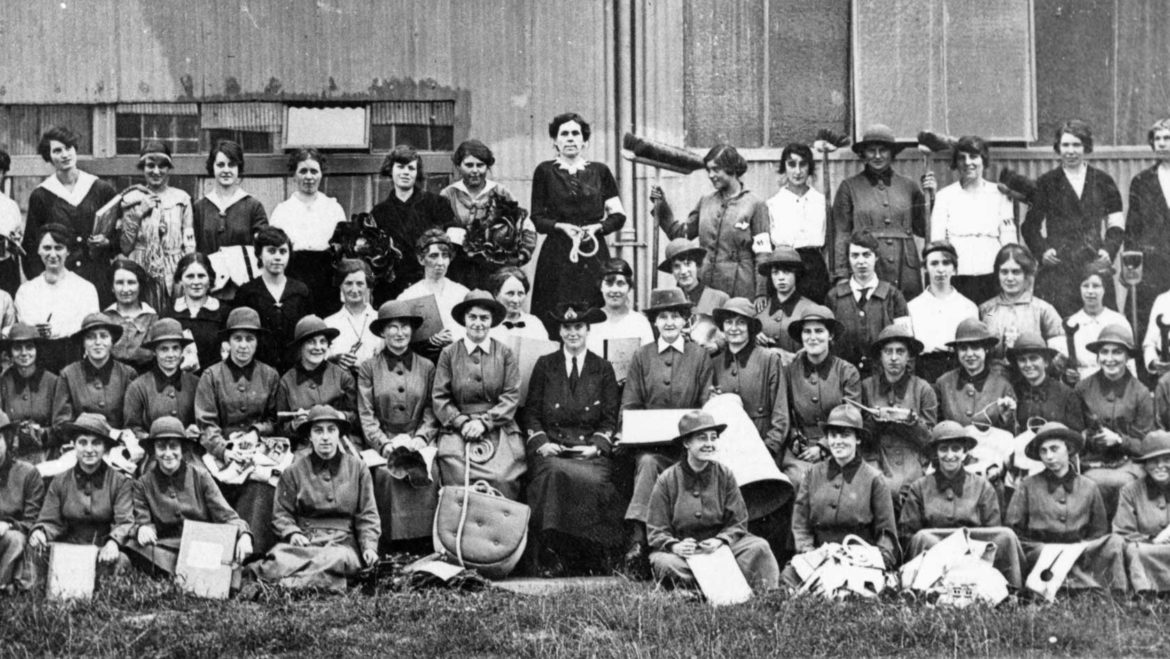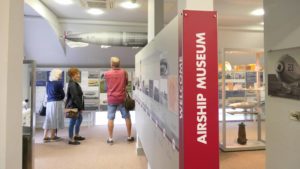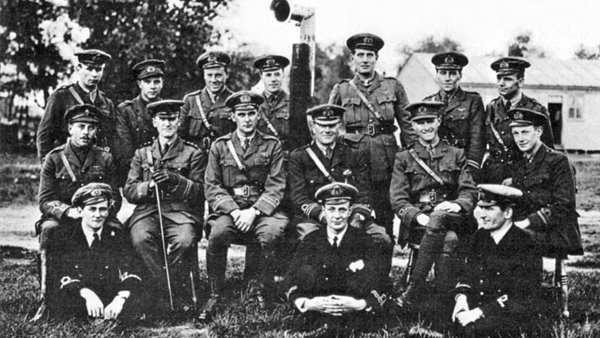
Welcome to the Airship Museum and the fascinating history of Norfolk’s finest flying pigs!
Our Airship Museum tells the story of RNAS Pulham, its people and its amazing airships.
Quick Jump
What was the RNAS?
The Royal Naval Air Service (RNAS) was the air arm of the Royal Navy and existed formally from 1914 –1918. The RNAS then merged with the British Army’s Royal Flying Corps, to form the Royal Air Force (RAF) — the first of its kind in the world. By the time it merged with the RFC on 1 April 1918 to form the Royal Air Force, the RNAS had 67,000 personnel and 103 airships.

The Pulham Pigs!
In August 1916, the first airship— a ‘Coastal’ type, C17 — arrived at RNAS Pulham. Coastal airships were almost 60m long and originally buff in colour, with a top speed of about 45mph. A crew of six was usually on board.
Pulham legend says that a local man saw a Coastal airship above him and exclaimed,
‘Thet luk loike a gret ol’’pig!’ — that looks like a great old pig to me!
And so, the name Pulham Pigs was born!
Pulham Air Station
RNAS Pulham was commissioned in 1916, part of a defensive network of air stations around the country, extending from Mullion in Cornwall to Longside, near Aberdeen. Airships from RNAS Pulham were sent to patrol the North Sea, to protect shipping from German U-boats.
As the war progressed, Pulham Air Station expanded to have two large sheds to house rigid airships alongside a smaller coastal airship shed. A railway line brought supplies into the base, and onsite both electricity and gas were generated.
At the peak of the war, over 3,000 service personnel were reportedly stationed at RNAS Pulham, with a further 2,000 civilians arriving daily to support its operations — over 500 men were needed to land some of the bigger airships, and large numbers of men, and women, were involved in maintaining the giant craft.
Airships
Airship development adopted different designs as the Admiralty, and individual airship stations, sought to improve on previous models. Early airships were ‘non rigid’, with hydrogen gas bags held within a canvas outer envelope. The control car – or gondola – in these early ships was often constructed from obsolescent aircraft fuselages and was suspended beneath the envelope. Non-rigid airships include ‘Sea Scout’, ‘Coastal’ and ‘North Sea’ models.
Later airships were ‘rigid’, copies of the more successful German Zeppelins, with a lightweight framework to maintain the shape of the airship and contain the gas bags. Rigid airships were much larger — up to 198m long — and were capable of longer flying times and higher speeds.
Pulham’s Airships
Airships were transferred around the network of air stations. Almost 50 different airships are known to have been based at Pulham for periods of varying lengths, initially supporting the defence of the North Sea, then later involved in experiments. Notable airships include:
- A non-rigid Coastal airship, the C17 conducted early parachute experiments in 1917. She was shot down over the North Sea later that year, with the loss of all crew.
- A rigid airship, the R23 spent most of her flying hours at Pulham involved in experimentation – such as releasing fighter planes in mid-air. She escorted surrendered U-boats into Harwich harbour in 1918.
- In 1925, the R33 came to global attention after breaking free from her moorings at Pulham and drifting out of control for 30 hours over the North Sea, as the skeleton crew struggled to bring her to safety.
- In 1919, the R34 airship made aviation history, landing at Pulham to complete the first ever two-way flight across the Atlantic, with a crew of 30. This was just six weeks after Alcock and Brown completed the first ever transatlantic flight.
- Two days after the arrival of the R34, the NS11 flew from Pulham, possibly attempting to recover her endurance record. She was lost, with all her crew, in a storm off the north Norfolk coast.
What happened to RNAS Pulham?
After World War I through to the mid-1920s, Pulham continued as the Airship Experimental Station, part of the newly-formed RAF. When the focus of the airship industry was switched to Cardington in Bedfordshire, Pulham became an RAF maintenance unit.
In World War II, RAF Pulham was the aircraft salvage site for all of the East of England, then continued post-war as a maintenance site, until 1958, when it was finally closed down.
In 1962, the site was sold at auction, and the land returned to farming once more.
Today, little remains of the giant station of WWI.
The airship industry
Civilian air travel became the focus for airship development. The vision was to connect up the British Empire, with mass air transport by airship, enabling people to travel to Canada, Africa, India and Australia in style and comfort.
However, in October 1930, the giant R101 airship carrying 54 people on its inaugural flight to India, crashed into a hillside in northern France and burst into flames. There were only six survivors. Many of those who died were pioneers of airship development; also on board were senior politicians, including the Secretary of State for Air, and the Director of Civil Aviation.
Inevitably, the loss of the R101 spelled the end of the airship industry in the UK.
Did you know?
- In July 1919, the world’s attention focused on Pulham, when the R34 airship landed there to complete the first ever two-way flight over the Atlantic. The R34 had flown from Scotland to New York, where thousands of people turned out to welcome her and her crew (including a stowaway, a pet cat and two carrier pigeons!). She was diverted to Pulham at the end of her return flight, giving Pulham her place in aviation history.
- In September 1917, RNAS Pulham became an experimental site in addition to its flying and training duties. Experiments included the use of parachutes: first with dummies and then with live parachutists; mooring airships; launching fighter planes from airships.
- By 1928 Pulham’s largest shed had been taken to Cardington, where it can still be seen today, dominating the Bedfordshire skyline. Owned by Warner Brothers, it has been used for many of their films.
Read more about the fascinating history of RNAS Pulham and its airships
Want to view our fascinating airship collection? Visit our museum!


